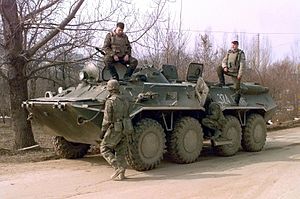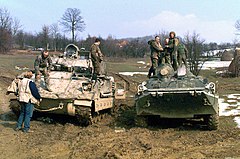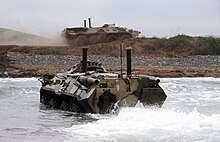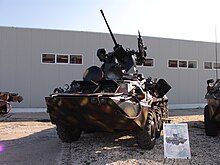| Revision as of 14:46, 29 April 2012 edit46.164.105.1 (talk)No edit summary← Previous edit | Revision as of 10:54, 2 May 2012 edit undoTabletop (talk | contribs)Autopatrolled, Extended confirmed users, Pending changes reviewers177,774 editsm Spell begining => beginning (0164)Next edit → | ||
| Line 141: | Line 141: | ||
| * {{flag|Hungary}} - 513 BTR-80 and 178 BTR-80A obtained in exchange for Russian government debt. 3rd largest operator. | * {{flag|Hungary}} - 513 BTR-80 and 178 BTR-80A obtained in exchange for Russian government debt. 3rd largest operator. | ||
| * {{flag|India}} | * {{flag|India}} | ||
| * {{flag|Indonesia}} - Indonesian Navy Marine Corps (Korps Marinir TNI-AL) use BTR-80 for their 1st Cavalry Regiment (Resimen Kavaleri 1) of the 1st Marine Force. From 2006, 12 BTR-80A serving for Indonesian UNIFIL Mission in Lebanon.<ref></ref> | * {{flag|Indonesia}} - Indonesian Navy Marine Corps (Korps Marinir TNI-AL) use BTR-80 for their 1st Cavalry Regiment (Resimen Kavaleri 1) of the 1st Marine Force. From 2006, 12 BTR-80A serving for Indonesian UNIFIL Mission in Lebanon.<ref></ref> | ||
| * {{flag|Iraq}} - 50 BTR-94, 98 BTR-80UP ordered (first deliveries in 2006). | * {{flag|Iraq}} - 50 BTR-94, 98 BTR-80UP ordered (first deliveries in 2006). | ||
| * {{flag|Ivory Coast}} 6 BTR-80 from Belarus | * {{flag|Ivory Coast}} 6 BTR-80 from Belarus | ||
| Line 155: | Line 155: | ||
| * {{flag|Romania}} - 70 TAB Zimbru | * {{flag|Romania}} - 70 TAB Zimbru | ||
| ]n BTR-80 swimming.]] | ]n BTR-80 swimming.]] | ||
| * {{flag|Russia}} - 3500-4000 BTR-80/80A/82A. |
* {{flag|Russia}} - 3500-4000 BTR-80/80A/82A. Beginning from 2010, BTR-80 not purchased<ref>http://ria.ru/analytics/20111028/473552613.html</ref>. Receive only the BTR-82A | ||
| * {{flag|Sri Lanka}} - 33 BTR-80/80A<ref></ref> | * {{flag|Sri Lanka}} - 33 BTR-80/80A<ref></ref> | ||
| * {{flag|Sudan}} - 30 BTR-80A (known as '''Shareef''') | * {{flag|Sudan}} - 30 BTR-80A (known as '''Shareef''') | ||
Revision as of 10:54, 2 May 2012
| This article needs additional citations for verification. Please help improve this article by adding citations to reliable sources. Unsourced material may be challenged and removed. Find sources: "BTR-80" – news · newspapers · books · scholar · JSTOR (May 2010) (Learn how and when to remove this message) |
| This article's lead section may be too short to adequately summarize the key points. Please consider expanding the lead to provide an accessible overview of all important aspects of the article. (May 2010) |
| BTR-80 | |
|---|---|
 A Russian BTR-80 in Zvornik, Bosnia and Herzegovina A Russian BTR-80 in Zvornik, Bosnia and Herzegovina | |
| Type | Armoured personnel carrier |
| Place of origin | |
| Service history | |
| In service | 1986–present |
| Specifications | |
| Mass | 13.6 tonnes |
| Length | 7.7 m |
| Width | 2.9 m |
| Height | 2.41 m |
| Crew | 3 (+7 passengers) |
| Armor | Classified |
| Main armament | 14.5mm KPVT machine gun |
| Secondary armament | 7.62mm PKT machine gun |
| Engine | diesel KamAZ-7403 260 hp (190 kW) |
| Power/weight | 19 hp/tonne |
| Suspension | wheeled 8×8 |
| Operational range | 600 km |
| Maximum speed | 80-90 km/h, swim 10 km/h |
The BTR-80 is an 8x8 wheeled amphibious armoured personnel carrier (APC) designed in the Soviet Union. Production started in 1986 and replaced the previous versions, BTR-60 and BTR-70 in the Soviet army. (Template:Lang-ru, BTR stands for bronetransportyor literally "armoured transporter")
Description
The Soviets based the BTR-80 on the BTR-70 APC. It has a single 260-hp, V-8 turbocharged, water-cooled, diesel engine, an improvement over the twin gasoline engines installed in the BTR-60 and BTR-70 vehicles. The reconfigured rear portion of the hull accommodates a new, single engine. The Soviets removed the roof chamfers of the modified BTR-70, raised the rear, and squared off the rearward-sloping engine compartment. Standard equipment include TNPO vision blocks, optical devices TNP-B and TKN-3 for the driver and commander, an OU-3GA2M infra-red search light, six 81 mm smoke grenade launchers 902V "Tucha", a radioset (R-173 or R-163-50U), an intercom and hydrojets.
Capabilities
The Soviets modified the truncated cone turret used on the BTR-70 for the BTR-80 by redesigning the mantlet. This allows the 14.5mm KPVT and coaxial 7.62mm PKT machine guns to be elevated to a maximum of 60 degrees. This high angle of fire is useful in engaging targets on steep slopes, in urban fighting, and for engaging low flying air targets. The Soviets have also modified the design and positioning of the firing ports; the ports are now round, rather than tear-shaped, and have ball mounts similar to those used on the BMP-1. The forward firing ports now sit in angled recesses which allow infantry to fire from the front of the vehicle.

The redesigned side doors are split horizontally. The upper portion opens forward; this gives dismounting troops some protection against small arms fire from the front of the vehicle. The lower portion opens down, forming a step. Six smoke grenade projectors are mounted on the rear of the turret.
The BTR-80 can also climb a slope with up to 60% gradient and climb a vertical step of 0.5m
Remarks
In 1984, the Soviets began production of a diesel-engined variant of the BTR-70, which they called the BTR-80. The Soviets have retrofitted some BTR-70s with several of the improvements incorporated into the BTR-80, including the high-angle-of-fire turret. The 30 mm cannon-armed variant's armor-piercing ammunition can penetrate even the side armor of older model T-72 tanks. Firing ports in the side are facing forwards at an angle, so the crew cannot fend off an attack from the rear with their individual weapons (as the bulky engine occupies the whole rear third of the vehicle's interior). Another deficiency is that the turret is not stabilized, so accurate fire on the move is limited (only at low speeds), and the rotation mechanism is manually operated (with hand cranks), so the BTR-80A's 30mm cannon is not usable against helicopters, although its high-powered ammunition would make it a suitable anti-helicopter weapon. The gunner's position was designed with complete disregard for ergonomics: it is extremely cramped and the optical sights are located such that continuous monitoring would be near impossible due to muscle spasms. The basic variant is underpowered, the engine doesn't have enough reserve power to operate air conditioning and still provide enough speed, and also makes it impossible to install an electrical or hydraulic auxiliary drive to the turret. When used in peacekeeping missions all tires needed to be changed every 1,000 kilometers (the Russian-made, non-standard sized wheels were a problem in the field: they were designed specially for dirt roads, while for example in Iraq the BTR-80's used only paved roads due to the danger of sinking in the sand and the threat of mines, which has led to very rapid tire wear.) Armor protection is not sufficient compared to the latest Western vehicles (for example MRAP's). A single RPG hit to the vehicle is usually lethal. The BTR is also very vulnerable to mines. In the Afghan war and later conflicts, Russian soldiers usually rode on top, and not inside of the vehicle, as they were more likely to get killed inside than outside in case of an RPG or mine hit.
Versions
Russian Federation

- BTR-80 (GAZ-5903) - armoured personnel carrier.
- BTR-80M - improved model with DMZ-238M2 engine of 240 hp, a slightly longer hull and new tires. In production since 1993. It is understood that only a small number was produced until the original engine was ready for production again.
- BTR-82 - latest production version with improved armour, more modern night vision device TKN-4GA, GLONASS navigation system and a more powerful engine of 300 hp. The original armament is retained but is now installed in the BPPU turret of the BTR-80A/BTR-82A. The prototype of the BTR-82 was shown for the first time in November 2009.
- BTR-80K (GAZ-59031) (komandnyj) - command vehicle APC with telescopic antenna mast, TNA-4 navigation device and R-168 series of radio equipment.
- BTR-80A (GAZ-59034) - IFV See pictures with 30 mm gun 2A72 and 300 rounds as primary weapon. The turret is called BPPU and is equipped with sights 1PZ-9 (day) and TPN-3 or TPN-3-42 "Kristall" (night).
- BTR-80S - variant of the BTR-80A with KPVT.
- BTR-80AK - command variant of the BTR-80A with two whip antennas in the rear corners and with only 1 firing port on the right hull side.
- BRDM-3 (bronirovannaya razvedivatel’no-dozornaya mashina) - reconnaissance vehicle, based on the BTR-80AK and with a new day/night vision device in front of the commander's position. The crew consists of 6 men. Note that in some Western sources, the name BRDM-3 is incorrectly used for the 9P148 ATGM carrier.
- BTR-82A - latest production version with improved armour, more modern night vision device TKN-4GA-02, 30mm gun 2A72, GLONASS navigation system and a more powerful engine of 300 hp. The prototype of the BTR-82A was shown for the first time in November 2009. About 300 are operated by Russian Army since 2010.

- 2S23 "Nona-SVK" - fire support vehicle with the same 120 mm 2A60 rifled gun/mortar as the 2S9 Anona and a crew of 4.
- BREM-K (GAZ-59033) (bronirovannaya remontno-evakuatsionnaya mashina) - armoured recovery vehicle with towbars, a winch, welding equipment and a light crane.
- KM-80 or BTR-80 PBKM - command vehicle.
- RKhM-4 (razvedivatel’naya khimicheskaya mashina) - NBC reconnaissance vehicle with detection devices including the IMD-21BA and DP-5V, an automatic chemical alarm system GSA-12, a detection set for chemical agents KPKhR-3, an MK-3M meteo set, a KPO-1 sampling device, an ASP automatic detector and a KZO-2 flag dispenser to mark contaminated areas.
- RKhM-4-01 - improved version with more modern equipment, including the GSA-13, IMD-1R, ASP-12 systems, a PGO-11 semi-automatic detection device, R-171M and R-173M radios instead of the older R-123M.
- RKhM-4-02 - with upgraded detection systems such as the ASP-13, IMD-2NM and IMD-23, GSA-14; analysis, storage and interface unit UIK-RKhB and T-235-1U COMSEC equipment.
- RKhM-6 "Povozka" - latest version with state-of-the-art detection systems including the PRKhDD-2B with a detection range of about 3 km. Furthermore the RKhM-6 is equipped with an inertial navigation system SN-RKhM and a satellite navigation system 14Ts834.
- RPM-2 - mobile radiological reconnaissance station with KRPI system. In service since 2000. Might also be known as NKR (nazemnij kompleks radiatsionnoj razvedki, "ground nuclear recon complex").
- R-149BMRA - command and signals vehicle.
- R-149MA3 - command and signals vehicle.
- R-439-BK1 - SatCom station.
- "Tajfun" - planned version for Strategic Rocket (RVSN) units that will replace the base security vehicles MBP on BTR-60/70 chassis. The BTR-80 version will have a new turret with 7.62 mm machine gun, new observation device TKN-4S and a "Kredo-1" radar.
- ZS-88 (zvukoveshchatel’naya stantsiya) - PsyOps vehicle with loudspeaker set.
- ZS-96 (zvukoveshchatel’naya stantsiya) - PsyOps vehicle with loudspeaker set.
- K1Sh1 (GAZ-59032) - command post vehicle with bigger hull and unarmed turret. Also known as UNSh (unifitsirovannyj shassi, "unified chassis"). This version serves as the basis for several specialised vehicles, but Estonia uses the type as APC with machine gun turret.
- BMM-80 "Simfoniya" (GAZ-59039) (bronirovannaya mnogofunktsionalnaya meditsinskaya mashina) - armoured ambulance, comes in three versions: BMM-1 (first aid and evacuation from the battle field), BMM-2 (initial medical treatment at battalion-level) and BMM-3 (mobile field hospital). Each vehicle can transport 9 patients, including two on stretchers on the rear hull. Developed in 1993.
- E-351BrM - mobile electric power station. The vehicle is equipped with an AD-30T/400 diesel-electric generator that can deliver power to up to 15 signals vehicles. It has a 2-men crew.
- PU-12M6 (9S482M6) (punkt upravleniya) - battery command vehicle (BKP - batarejnyj kommandnyj punkt) for air defence units equipped with "Strela-1M" (SA-9), "Strela-10M2 (SA-13), "Osa-AK" (SA-8), 2S6 "Tunguska" and ZSU-23-4 "Shilka".
- PU-12M7 (9S482M7) - improved version.
- 1V152 - command and forward observer vehicle for field artillery units. The standard equipment consists of range finders, dag/night vision devices, navigation equipment etc. The 1V152 and 1V153 (on Ural-4320 truck) belong to the KSAUO "Kapustnik-B" set.
- R-149BMR - signals vehicle, equipped with R-168-100KA “Akveduk-100KA”, R-168-100U, R-163-25U, R-163-10V, and R-163-1V “Arbalet” HF/VHF radio sets, AVSK intercom, P-338 video system, AD-3,5U-28,5 generator, ASh-4 telescopic mast, AZI NVIS HF antenna and ShDA-50 Discone-type antenna.
- R-149MA3 - command and signals vehicle.
- R-165B - HF signals vehicle equipped with “Arbalet-500K”, R-163-10V and -50, R-163-AR radios, R-016V "Vishnya" HF link equipment and an AB-4U-P28.5-1V generator. The radio sets have a declared range of 20–350 km on the move and 40–1000 km deployed.
- R-439-MD2 - SatCom station.
- R-439-BK "Legenda 2BK" - SatCom station, operates within 3400-3900 MHz (receiption) and 5725-6225 MHz (transmission) ranges.
- P-240BTZ - switchboard vehicle with "Zenit" set. Planned as successor for the BTR-60 based P-240BT.
Colombia
- BTR-80 "Caribe" - version for Colombian marines with .50cal machine gun instead of 14.5 mm KPVT. 100 ordered. Caribe project is assembled in COTECMAR (Corporación Tecnológica del Mar Caribe) Plant in Cartagena de Indias, Colombia
Estonia
- BTR-80UNSh (EST) - Estonian version of the BTR-80. After Estonia re-gained independence in 1991, about 20 BTR-80s were taken over from Russian contrabandists and used until 2005 as infantry squad carriers. Replaced by Sisu XA-180EST APCs.
Hungary
- BTR-80M - Upgraded version with passive day/night sight KM-1M on top of the roof, stowage box for water bottles on the left hull side, improved NBC protection system and Kronsberg radio set.
- BTR-80 GKKO - Turret-less version with observation equipment. Prototype.
- BTR-80 MPAEJ (műszaki páncélozott akadály elháritó jármű) - Unarmed combat engineer version without turret. In service.
- BTR-80 MPFJ (műszaki páncélozott felderitő jármű) - Unarmed obstacle clearing vehicle without turret. In service.
- BTR-80 MVJ (mentő-vontató jármű) - Repair and recovery vehicle with crane and winch. In service.
- BTR-80 SKJ (sebesült kihordó jármű) - Much modified ambulance version with bigger troop compartment.
- BTR-80 VSF (vegyi-sugár felderítő jármű) - NBC reconnaissance vehicle. In service.
Romania

- TAB Zimbru (B33) (transportorul amfibiu blindat) - modified version of the BTR-80 with Model 1240 V8-DTS engine of 268 hp (197 kW), R-1231B radio set and 500 additional rounds 7.62 mm. Made by CN RomArm SA.
- Zimbru 2000 - improved version with bigger hull, new Deutz BF6M 1013FC 285 hp (212 kW) engine, new transmission Allison-MD 3060 PR etc. Can be fitted with a new turret like the OWS 25R. Prototype.
Ukraine
- BTR-80UP - improved version, produced in Ukraine in cooperation with Poland for Iraq (98 planned). Fitted with a new 300 hp engine, additional armour and airconditioner.
- BTR-80UP-KB - battalion level command vehicle.
- BTR-80UP-KR - company level command vehicle.
- BTR-80UP-S - staff vehicle.
- BTR-80UP-M - ambulance.
- BTR-80UP-BREM - recovery vehicle.
- BTR-80UP-R - reconnaissance version.
- BTR-80UP-T - cargo version.
- BTR-94
- BTR-3U "Okhotnik"
- KShM "Kushetka-B" - command vehicle, based on the K1Sh1 chassis and developed by Radiopribor from Ukraine. The specialised equipment consists of the HF radioset “Berkut-M”, VHF sets R-171M, R-173M “Abzats-M”, R-163-50U, R-163-10V and R-163-1V “Arbalet” (with a range from 5 to 350 km). Other equipment include a navigation apparatus (probably TNA-4-6), a generator AB-1-P28,5-B-V1 and telescopic antenna masts DLYa4.115.002 and DLYa2.091.008.
Operators
There are over 5,000 BTR-80s in service in various armies around the world:

 Afghanistan
Afghanistan Algeria
Algeria Angola
Angola Armenia - 50 in service of the Armenian Army.
Armenia - 50 in service of the Armenian Army. Azerbaijan - 70 in service of the Azerbaijani Army.
Azerbaijan - 70 in service of the Azerbaijani Army. Bangladesh - 1025 2nd largest operator after Russian Ground Forces.
Bangladesh - 1025 2nd largest operator after Russian Ground Forces. Belarus - 194
Belarus - 194 Colombia - 5 in service, Initially 100 units would be assembled under license in Colombia, the project was canceled.
Colombia - 5 in service, Initially 100 units would be assembled under license in Colombia, the project was canceled. Djibouti
Djibouti Estonia
Estonia Finland - 2 acquired in July 1990, Ps 690-1 and Ps 690-2 for evaluation (XA-185 was selected)
Finland - 2 acquired in July 1990, Ps 690-1 and Ps 690-2 for evaluation (XA-185 was selected) Georgia
Georgia Hungary - 513 BTR-80 and 178 BTR-80A obtained in exchange for Russian government debt. 3rd largest operator.
Hungary - 513 BTR-80 and 178 BTR-80A obtained in exchange for Russian government debt. 3rd largest operator. India
India Indonesia - Indonesian Navy Marine Corps (Korps Marinir TNI-AL) use BTR-80 for their 1st Cavalry Regiment (Resimen Kavaleri 1) of the 1st Marine Force. From 2006, 12 BTR-80A serving for Indonesian UNIFIL Mission in Lebanon.
Indonesia - Indonesian Navy Marine Corps (Korps Marinir TNI-AL) use BTR-80 for their 1st Cavalry Regiment (Resimen Kavaleri 1) of the 1st Marine Force. From 2006, 12 BTR-80A serving for Indonesian UNIFIL Mission in Lebanon. Iraq - 50 BTR-94, 98 BTR-80UP ordered (first deliveries in 2006).
Iraq - 50 BTR-94, 98 BTR-80UP ordered (first deliveries in 2006). Ivory Coast 6 BTR-80 from Belarus
Ivory Coast 6 BTR-80 from Belarus Kazakhstan - 190 BTR-80, 90 BTR-80A
Kazakhstan - 190 BTR-80, 90 BTR-80A Kenya - 8 BRDM-3, arrived in early 2012 from Russia.
Kenya - 8 BRDM-3, arrived in early 2012 from Russia. Kyrgyzstan - 8
Kyrgyzstan - 8 Macedonia - 12
Macedonia - 12 Moldova - 11
Moldova - 11 Mongolia - 450 are in service as of 2011.
Mongolia - 450 are in service as of 2011. Morocco
Morocco North Korea - 32 BTR-80A (according to SIPRI trade registers)
North Korea - 32 BTR-80A (according to SIPRI trade registers) Pakistan - BTR-70 / BTR-80
Pakistan - BTR-70 / BTR-80 Romania - 70 TAB Zimbru
Romania - 70 TAB Zimbru

 Russia - 3500-4000 BTR-80/80A/82A. Beginning from 2010, BTR-80 not purchased. Receive only the BTR-82A
Russia - 3500-4000 BTR-80/80A/82A. Beginning from 2010, BTR-80 not purchased. Receive only the BTR-82A Sri Lanka - 33 BTR-80/80A
Sri Lanka - 33 BTR-80/80A Sudan - 30 BTR-80A (known as Shareef)
Sudan - 30 BTR-80A (known as Shareef) Tajikistan - 26
Tajikistan - 26 Turkey - 214
Turkey - 214 Turkmenistan - 40
Turkmenistan - 40 Ukraine - 456
Ukraine - 456 Uzbekistan - 290
Uzbekistan - 290 South Korea - 20 delivered in 2007
South Korea - 20 delivered in 2007 Venezuela - 270 ordered. 32 BTR-80A, 13 2S23 and 4 1V152 delivered in May 2011.
Venezuela - 270 ordered. 32 BTR-80A, 13 2S23 and 4 1V152 delivered in May 2011. Oman - ?
Oman - ?
See also
- AMX 10 RC
- Pandur 8X8 APC
- Pandur 6x6 APC
- B1 Centauro
- LAV 600
- MOWAG Piranha family tree
- Mowag Piranha
- LAV III
- Stryker
- NZLAV
- FNSS Pars
- Mobile Gun System
- ASLAV
- LAV-25
- BTR-90
- Patria Pasi aka Sisu Pasi
- Patria AMV
- KTO Rosomak
- Pindad Panser
Museum exhibits
References
- Zaloga 1990: "The turret on the BTR-80 uses a new trunnion mounting which gives greater elevation for firing at enemy helicopters."
- http://www.military-today.com/apc/btr_80.htm
- ^ http://federalbook.ru/files/Reestr/Company/OPK-5/7549OPK5-Zavod%20Tula.pdf
- "Капустник-Б", автоматизированная система управления огнем ствольной артиллерии, минометов и реактивных систем залпового огня — ОРУЖИЕ РОССИИ, Федеральный электронный справочник вооружения и военной техники
- лБРХУФОЙЛ-в :: чойй "уЙЗОБМ"
- Colombia: Seguridad y Defensa
- eredmeny
- névtelen
- névtelen
- névtelen
- névtelen
- névtelen
- Altair - R-wto 12/2006 - BTR-80UP do Iraku. Sokoły chyba nie
- Военная кафедра МТУСИ :: Командно-штабная машина "Кушетка-Б" на транспортной базе БТР-80
- IISS (2007). The Military Balance 2007. London: Routledge for the IISS. p. 155. ISBN 978-1-85743-437-8.
- List of military techniques Azerbaijan acquired over the past 7 years
- Belarus Army Equipment
- BTR-80, Kendaraan Tempur Angkut Pasukan
- http://ria.ru/analytics/20111028/473552613.html
- Asia Times, Deadly arsenals dot Sri Lanka
- Tajik-Army Equipment
- Ground Forces Equipment - Ukraine
- http://www.panssarimuseo.fi/index-kuvat/Museonkesa2011-7.pdf
- Zaloga, Steven J. (1990). Soviet Wheeled Armored Vehicles. Hong Kong: Concord Publications. ISBN 962-361-013-0.
- Hull/Markov/Zaloga (1999). Soviet/Russian Armor and Artillery Design Practices: 1945 to Present. Darlington Productions. ISBN 1-892848-01-5
- UN register of conventional arms
External links
- Technical data sheet and pictures BTR-80 ArmyRecognition.com
- Army Technology BTR-80 Project Details
- Global Security BTR-80 Details
- FAS page
- About BTR-80 series (in Russian)
- Pictures of early BTR-80
- Website of AMZ: military BTR-80 versions
- Website of AMZ: special versions of BTR-80
- Walkarounds on BTR-80s, BTR-80As, BTR-80AMs, and on Hungarian modifications
| Soviet and Russian armoured fighting vehicles after World War II | |||||||||
|---|---|---|---|---|---|---|---|---|---|
| |||||||||
| |||||||||
| |||||||||
| |||||||||
| |||||||||
Categories: